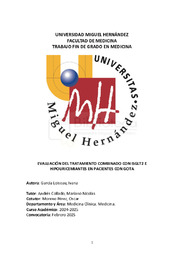Por favor, use este identificador para citar o enlazar este ítem:
https://hdl.handle.net/11000/37637Evaluación del tratamiento combinado con ISGLT2 e hipouricemiantes en pacientes con gota.
| Título : Evaluación del tratamiento combinado con ISGLT2 e hipouricemiantes en pacientes con gota. |
| Autor : García Loiseau, Ivana |
| Tutor: Moreno Pérez, Óscar |
| Editor : Universidad Miguel Hernández |
| Departamento: Departamentos de la UMH::Medicina Clínica |
| Fecha de publicación: 2025-02-05 |
| URI : https://hdl.handle.net/11000/37637 |
| Resumen : ANTECEDENTES: Los ISGLT2 han demostrado beneficios sustanciales en diabetes mellitus, insuficiencia cardíaca, e insuficiencia renal. En estudios pivotales, los ISGLT2 redujeron los niveles de uricemia, sin embargo, la evidencia en práctica clínica es escasa. OBJETIVOS: Evaluar los resultados de uricemia en pacientes con gota tratados con ISGLT2 e hipouricemiantes en práctica clínica. MÉTODOS: Estudio observacional, retrospectivo, unicéntrico, en pacientes con gota en tratamiento combinado con hipouricemiantes e ISGLT2, seguidos en consultas especializadas de Reumatología del Hospital Dr.Balmis. Se revisaron las historias clínicas de los pacientes que cumplían los criterios de inclusión y fueron excluidos aquellos sin niveles de uricemia disponibles en los 6 meses antes o después del tratamiento combinado y aquellos que iniciaron terapia renal sustitutiva. La variable principal del estudio fue el nivel de uricemia pre- y post- ISGLT2 (mg/dL), analizada estadísticamente con el test de Wilcoxon como variable continua no paramétrica. Como variables secundarias medimos el porcentaje de consecución de objetivos (<6 mg/dL o <5 mg/dL), la dosis de alopurinol requerida (mg/día) y la dosis estimada mediante la fórmula Easy-Allo (mg/día). RESULTADOS: Se incluyeron 46 pacientes con una mediana de edad de 76 años, en su mayoría hombres (82,6%) y con elevada comorbilidad (91,1% DM, 58.7% ERC, 45,7% IC). El hipouricemiante fue prescrito inicialmente en el 81,4% (n=35), siendo la mayoría alopurinol (n=30, 66,7%) mientras que el ISGLT2 lo fue en el 18,6% (n=8), mayoritariamente dapagliflozina (n=27, 58,7%). El objetivo de uricemia <6 mg/dL se alcanzó en el 97,7% de los pacientes, y el 81,4% <5 mg/dL, sin relación con el tipo de fármaco inicial. El inicio del ISGLT2 mostró una reducción de uricemia de 0,9 mg/dL (RIC 3,025) independientemente del uso previo con hipouricemiantes o no. Además, se observó una tendencia hacia dosis empleadas de alopurinol más bajas respecto a las estimadas por la herramienta Easy-Allo y una reducción significativa en el uso de diuréticos tras inicio de ISGLT2. CONCLUSIONES: La combinación de ISGLT2 e hipouricemiantes en pacientes con gota alcanzó reducciones significativas de uricemia alcanzando objetivos terapéuticos, reduciendo el uso de diuréticos y con una tendencia a dosis requeridas más bajas de alopurinol. BACKGROUND: SGLT2I have proved substantial benefits in diabetes mellitus, heart failure, and kidney disease. In pivotal trials, SGLT2Is reduced serum urate levels, but the clinical evidence is scarce. OBJECTIVES: To evaluate the urate outcomes in patients with gout treated with SGLT2I and ULD in clinical practice. METHODS: Retrospective, single-center observational study, enrolling patients with gout undergoing combined treatment with ULD and SGLT2i, followed in the specialized Rheumatology clinics of Dr.Balmis, were included. Medical records of patients meeting the inclusion criteria were reviewed, and those without available uric acid levels 6 months before or after combined treatment or starting renal replacement therapy, were excluded. The main variable of the study was SU level pre- and post-SGLT2I (mg/dL) statistically analized using Wilcoxon test as a non-parametric continuous variable. As secondary variables, we measured the percentage achievement of SU target (<6 mg/dL or <5 mg/dL), the required allopurinol dose (mg/day) and estimated dose according to the Easy-Allo (mg/day). RESULTS: 46 patients were included: median age 76 years, 82.6% men and with high comorbidity (91.1% DM, 58.7% KD, 45.7% HF). ULD were initially prescribed in 81.4% (n=35), mostly allopurinol (n=30, 66.7%), while SGLT2I was prescribed in 18.6%, predominantly dapagliflozin (n=27, 58.7%). The target of SU <6 mg/dL was achieved in 97.7% of the patients and 81.4% <5 mg/dL, with no relation to the first prescribed medication. The start of SGLT2I showed a SU reduction of 0.9 mg/dL (IQR 3.02), regardless of being already on ULD or not. Regarding the required doses of allopurinol, a trend toward lower doses was observed compared to those estimated by the Easy-Allo tool. Also, we detected a significant reduction in diuretics use pre- and post-SGLT2I. CONCLUSIONS: The combination of SGLT2I and ULD in patients with gout in clinical practice achieved significant SU level reduction, reaching therapeutic targets, reducing diuretic use, and showing a trend towards a lower required dose of allopurinol. |
| Palabras clave/Materias: ISGLT2 hipouricemiantes tratamiento combinado con hipouricemiantes e ISGLT2 pacientes con gota |
| Área de conocimiento : CDU: Ciencias aplicadas: Medicina |
| Tipo de documento : info:eu-repo/semantics/bachelorThesis |
| Derechos de acceso: info:eu-repo/semantics/openAccess Attribution-NonCommercial-NoDerivatives 4.0 Internacional |
| Aparece en las colecciones: TFG- Medicina |
 La licencia se describe como: Atribución-NonComercial-NoDerivada 4.0 Internacional.
La licencia se describe como: Atribución-NonComercial-NoDerivada 4.0 Internacional.
.png)
